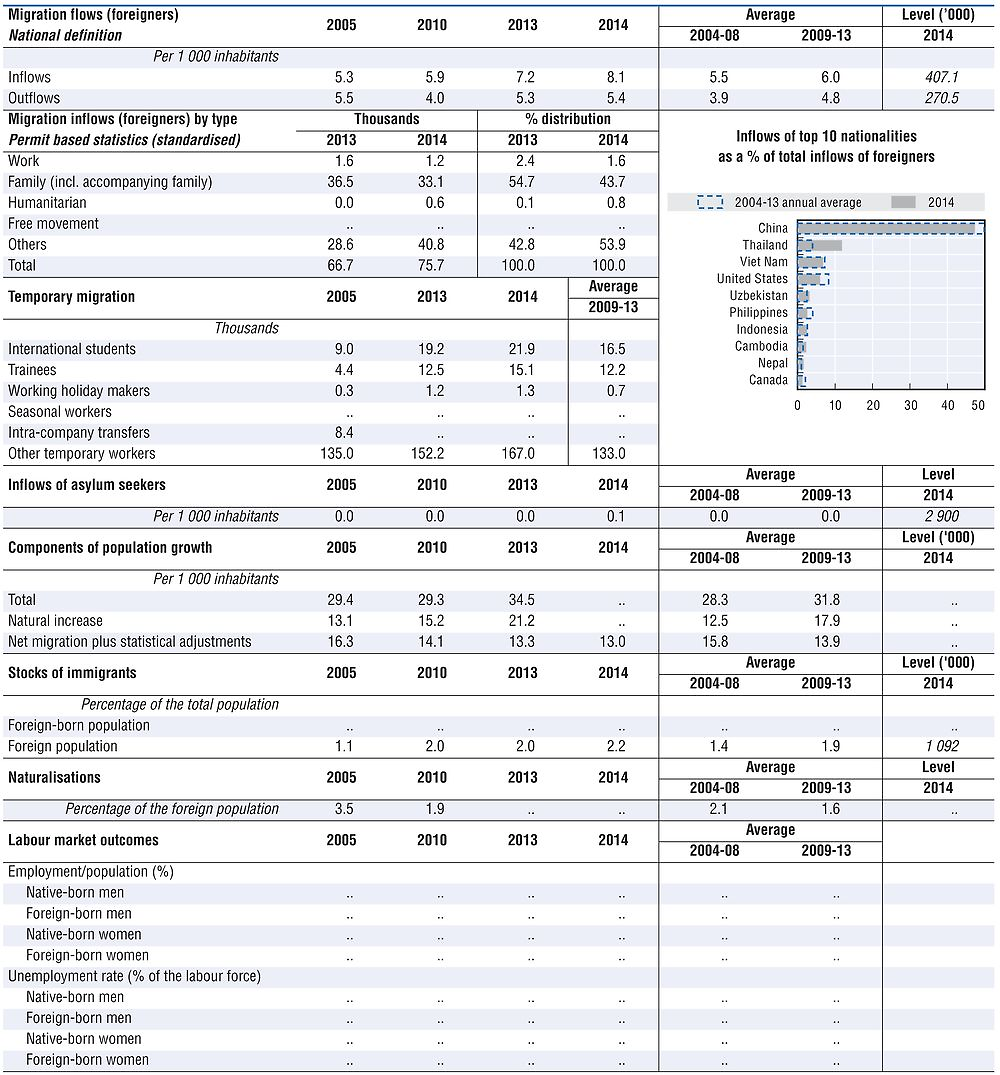Korea
Korea has experienced positive net migration of non-Koreans since the mid-2000s. In 2014, net migration was largely positive, reaching 136 500 compared to 92 400 the previous year. Labour migrants plateaued at 60% of all incoming foreign nationals, while students comprised 13% of entries and family migrants decreased to 10% of total inflows. The number of returning Korean nationals continued falling during 2014 but at a smaller pace, reversing their net emigration to a surplus of 5 100 persons.
The stock of foreign residents in Korea has been increasing steadily. The number of long-term foreign migrants (residing more than 90 days) increased from 1.38 million at the end of 2014 to 1.47 million one year later. Among these, the number of registered foreigners increased from 1.09 million to 1.14 million, while the number of registered ethnic Koreans increased from 286 400 to 324 800. The number of short-term stayers residing in Korea for less than 90 days also increased, from 419 700 to 431 700.
The stock of employment-based migration increased sharply, by 12% in 2014 and a further 1.3% in 2015, bringing the level of foreign workers (625 100) up to its 2011 level (595 100). The number of low skilled workers entering with an employment permit (E-9) decreased for the first time since 2009 to 51 600 (due to a reduction of the quota in 2014 to 53 000). Overall, 276 000 E-9 visa holders were registered in 2014, mainly working in manufacture. The H-2 visa allows working visits by ethnic Koreans (that quota was stable at 303 000). The number of new H-2 visas granted reached 278 600 in 2014 and 259 500 in 2015. In 2015, there were about 285 300 H-2 visa holders present in Korea, the majority of whom were Chinese nationals. For skilled employment, foreign language instructors (E-2) and special activity (E-7) visas remained the most common entry channels, with 7 000 and 3 900 new entrants, respectively in 2014.
Since 2010, the number of foreign students in degree programmes decreased steadily to 60 500 in 2013, but increased again over the following years to reach 66 300 in 2015 (but down its 2011 level). By contrast, language course students have been increasing continuously since 2010, reaching 30 000 in 2015. Chinese students accounted for two-thirds of all foreign students in 2014, followed by Vietnamese (6%) and Mongolians (4%).
The number of marriage migrants who had not yet naturalised reached 151 600 in 2015. Most marriage migrants were female. China was the main country of origin for foreign spouses (40%), followed by Viet Nam (26%), Japan (8%) and the Philippines (7%).
The number of asylum seekers has been growing over recent years, from 2 900 persons in 2014 to 5 700 in 2015. Main countries of origin were Pakistan (1 100), Egypt (800) and Syria (400). In 2015, 105 asylum seekers were recognised as refugees and 194 were granted humanitarian stay status.
The total number of unauthorised migrants who overstayed their visas rose slightly to 208 800 during 2014. Unauthorised status was more likely for low skilled labour migrants.
The procedure for an employer to notify a change in employment status for his or her low-skilled foreign worker (E-9, H-2) was simplified. The annual income requirement allowing high-tech professionals with at least a bachelor’s degree to acquire a permanent F-5 visa was lowered, from three times the Korean GNI per capita to that figure itself. With the introduction of a point system, the ways to access permanent resident status (F-5) have been diversified for professional foreign workers.
In 2015, a point system for selecting low-skilled foreign workers (for an E-9 visa) was pilot-tested and should be implemented in 2017. The points are based on Korean linguistic proficiency, work experience and occupation-related skill levels. The quotas of low-skilled foreign workers for the sectors of small establishments with high growth potential were increased by 20%. The quotas of these workers can now be adjusted across sectors, depending on how the foreign labour demand evolves in each sector. The required search duration for a domestic worker before hiring low-skilled foreign workers was shortened, from two weeks to one week for the sectors of agriculture, livestock and fishery.
The visa issue process for foreign students has been simplified. Moreover, foreign students are authorised to work 25 hours per week (five hours more than previously) during study.

